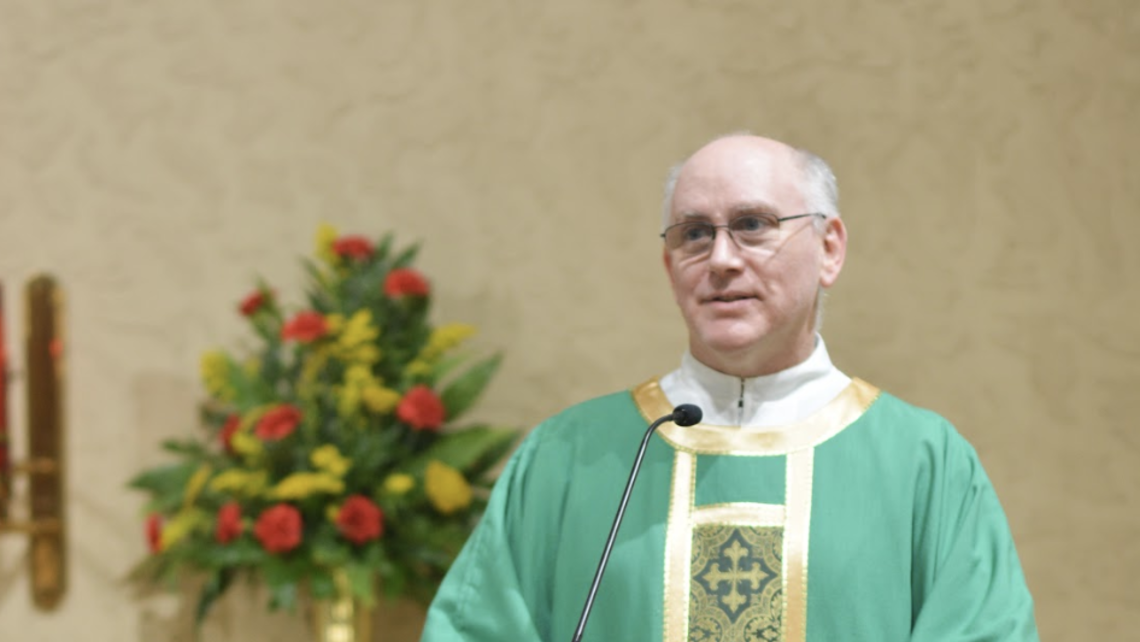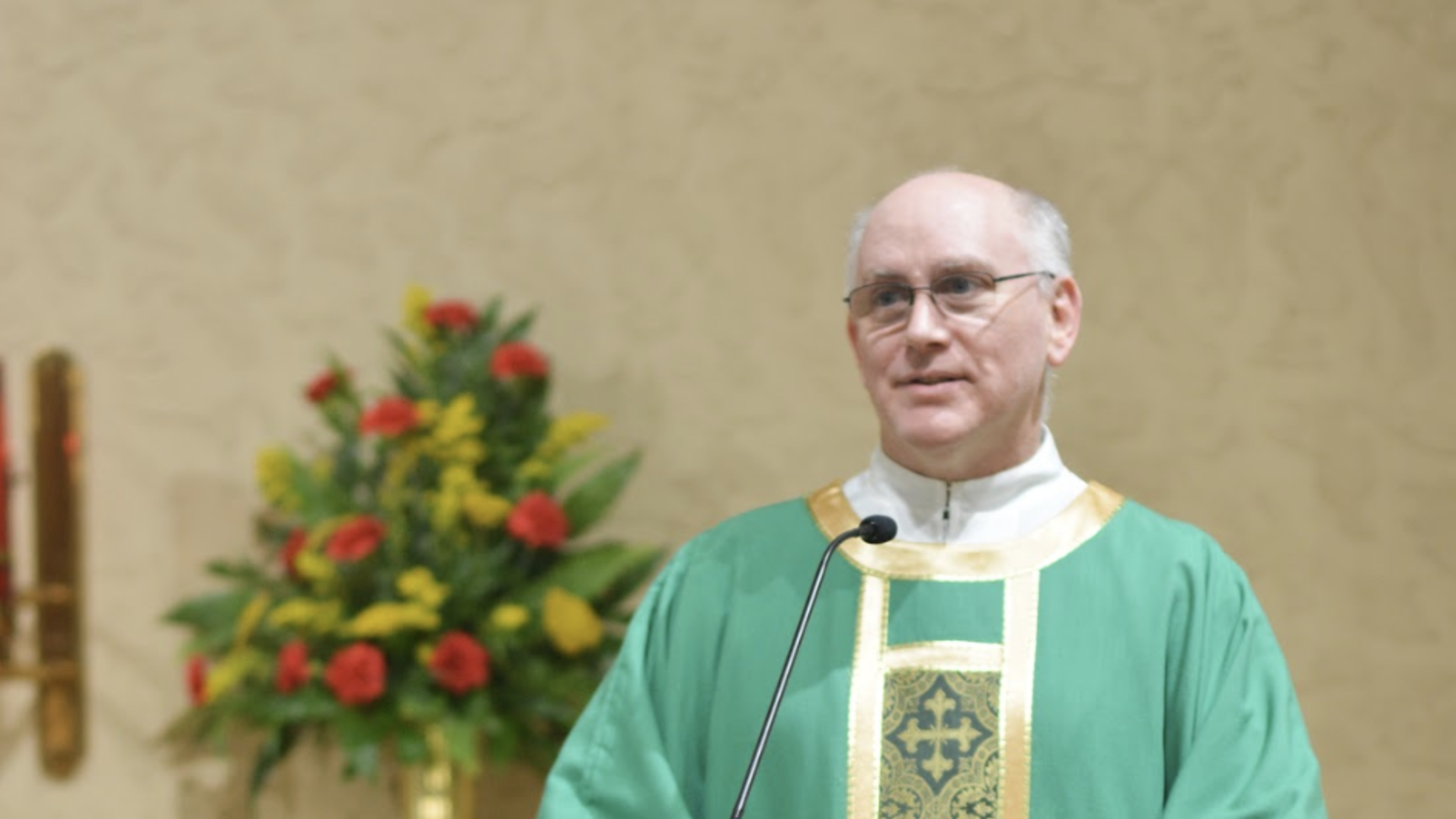
Fourth Sunday of Advent, Cycle C
Micah 5:1-4; Hebrews 10:5-10; Luke 1:39-45
For the last two homilies, I have started by talking about modern art. Today, I want to start off by talking about history, although this idea occurred to me because someone made a comment that a piece of history here in this church might be some sort of modern art or political statement. It isn’t either of those. Parishioners who have been here at Saint James for a while know this, but some newer arrivals probably don’t know the story, so it is appropriate that we occasionally remind ourselves of our history, just as during Advent we remind ourselves of the first coming of Christ to help us prepare for his second coming.
The crucifix which is suspended above the altar has two primary colors: brown and black. This is not some sort of artistic statement – the cross was all brown, the color of the wood from which it was sculpted and the color that you can see at the bottom and up one side, when it was originally installed on the back wall of this church, where the stained-glass window of the Last Supper is now. It, along with the two stained-glass windows at the corners of the front wall of this church, were the only things taken from the original much smaller St. James church, near where Nye’s Pharmacy is, when this larger church was built in 1994. Then, on New Year’s Day, 1996, a fire started along the wall directly behind me. An advent candle was accidentally left burning after the last Mass that day and, after burning down to the level of the wreath, lit it on fire, which spread to the carpet and then to the back of the sanctuary. That whole area was engulfed in flames before the fire department could arrive and put it out. But an interesting thing happened. There was a synthetic stucco known by its commercial name Dryvit on the wall, and the fire caused this coating to peel off, and a sheet of it came down and wrapped itself around the crucifix, putting out what was on fire and protecting it from further damage. As you can see, there was some charring, causing it to blacken, but the crucifix was otherwise left whole.
Now some people have called this a miracle. Others who save the idea of miracles to grander events might still see in it a hopeful sign of God’s providential care amid an otherwise bad situation, but of course that is what a miracle is, no matter how big or small. I would hope that most people would see in it a sign of rebirth of a community after a tragedy, a sign that, when we face difficulties in life, we find the strength to overcome them, and I would also hope that people also see God’s hand in the process. Sometimes it is not dramatic or highly visible – actually, almost always it is not dramatic or highly visible – but God has a plan and we are a part of it, whether we realize it, as do Mary and Elizabeth in today’s Gospel, or we choose to ignore it.
God’s plan was laid out from the beginning and has been gradually revealed over time to people over our history. The first reading is part of this process, where we hear the prophet Micah talking about little Bethlehem. Now people at the time of Jesus knew about the great King David being born and raised in Bethlehem, and David, the greatest king of Israel, had been a humble shepherd boy from this very small town. Out of a humble town God had great plans for David, and he had even more plans for this little town. The signs were there.
Then the Gospel takes up the theme of signs with two miracles. Two women conceive, one despite being a virgin and the other despite being old and considered barren, well past menopause. Both women have been blessed and know it. Skeptics down through the ages have tried to explain away every miracle in the bible, including these, or have discounted them as being caused by rare but scientifically valid preconditions, if they are charitable, or flat-out exaggerations or misinterpretations of facts, if they are not. But we look upon them with the eyes of faith, and we see God’s plan unfolding in human history. God chose a simple, very small town for the birth of the Son of God and chose two simple women to bear two important people: the Savior and the one to announce the Savior.
A challenge we must have during Advent is to see the working of God in history, and that includes our own personal history as well. God entered into our world in a real way, the incarnation, and this of course is a miraculous event. We must then look to our own lives and see God’s entering into our lives, also through blessings that we all experience every day, good things that come to us that we did nothing to deserve but we received them nonetheless. Small little signs, miracles, blessings – whatever we choose to call them and whatever attitude we take in recognizing them.
And this attitude we take is very important. The fact that these miracles, signs, blessings happen is not as important as our reaction to them, what we do in light of them. Jesus himself will confirm this, that Mary’s selection as the mother of God, as significant as this is, is not as important as her reaction to it. The Gospel of Luke relates that, one day, someone told Jesus that blessed was the woman who bore and raised him. However, Jesus answered and put this in perspective: he said that blessed even more were those “who hear the word of God and observe it” [Luke 11:27-28 NABRE]. We too are blessed by God in many ways, maybe not as dramatically as were Mary and Elizabeth. But after all, only one woman ever could bear the Son of God and only one woman could bear the Baptist to announce the Messiah. But we all can look at our own blessings and react with joy to them.
So when we look up when we are here at church, we have a choice. We can see just a charred piece of wood, or we can see a sign of a resilient community of disciples, a blessed people, a congregation that seeks to understand its role in God’s plan. This Christmas, we can see only the hassles, headaches, and cost of trying to bring happiness to our families and ourselves in the superficial, commercial way that secular society tries to tell us is Christmas, or we can appreciate the simple blessings, miracles really, that are part of God’s plan for our lives and take true joy at being together with our family and church community. It’s all in the way that you look at it and respond to it. And in the end, Advent is all about deciding how we look at it and respond to it.
As we continue with the Liturgy of the Eucharist, may the body of our Lord give us the blessings and strength to “hear the word of God and observe it.” As we approach Christmas, may we, like Mary and Elizabeth, glory in the presence of the Lord in our own hearts. May the cross here at Saint James always remind us to treasure the many blessings which we find in life, no matter how small and unmiraculous they seem.

